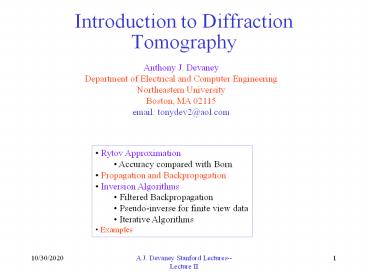Introduction to Diffraction Tomography PowerPoint PPT Presentation
Title: Introduction to Diffraction Tomography
1
Introduction to Diffraction Tomography
Anthony J. Devaney Department of Electrical and
Computer Engineering Northeastern
University Boston, MA 02115 email
tonydev2_at_aol.com
- Rytov Approximation
- Accuracy compared with Born
- Propagation and Backpropagation
- Inversion Algorithms
- Filtered Backpropagation
- Pseudo-inverse for finite view data
- Iterative Algorithms
- Examples
2
Historical survey
X-ray crystallography
Fourier based Born/Rytov inversion
Computed tomography
Conventional diffraction tomography
Statistical based methods
Diffraction Tomography
3
Complex Phase Representation
Ricatti Equation
4
Rytov Approximation
Perturbation introduced by the object profile
Rytov approximation
Rytov Model
5
Short Wavelength Limit
Classical Tomographic Model
6
Free Space Propagation of Rytov Phase
propagation
Within Rytov approximation phase of field
satisfies linear PDE
Rytov transformation
7
Solution to Rytov Model
Rytov transformation
Connection with Born approximation
Mathematical structure of models identical
8
Degradation of the Rytov Model with Propagation
Distance
Rytov and Born approximations become identical in
far field (David Colton)
Experiments and computer simulations have shown
Rytov to be much superior to Born for large
objects--Backpropagate field then use
Rytov--Hybrid Model
9
Experimental Tests
Sensor system
- Hybrid approximation
- Exact from measurement plane to near field
- Rytov from near field to object
Incident wave
Rytov
- Simulation and experiment
- optical fiber illuminated by red laser
- ray trace followed by free space propagation
- Rytov
- Hybrid
- Experiment
Measurement plane
Angular spectrum
10
Generalized Tomographic ModelDiffraction
Tomography
For the remainder of this lecture we will work in
two space dimensions
Generalized Projection (Propagation)
Diffraction tomography is generalization of
conventional tomography to incorporate wave
(diffraction effects)
11
Classical Geometry
y
Rotating coordinate system
Fixed coordinate system
x
12
Weyl Expansion for Classical Geometry in R2
Homogeneous Waves Evanescent Waves
Dirichlet Green Function
13
Propagation of Rytov Phase in Free Space
Angular Spectrum Representation of free space
propagation of Rytov phase
14
Propagation in Fourier Space --Backpropagation--
Free space propagation (? gt ?0) corresponds to
low pass filtering of the field
data Backpropagation (? lt ?0) requires high pass
filtering and is unstable (not well posed)
Propagation and Backpropagation of bandlimited
phase perturbations
15
Propagation Operator in Classical Geometry
y
x
16
Spectral Representation of Propagation Operation
Weyl Expansion in 2D
17
Generalized Projection-Slice Theorem
Ky
y
Kx
x
Ewald sphere
18
Short Wavelength Limit
Projection-Slice Theorem
Diffraction tomography ?Conventional tomography
as ??0
19
Backpropagation Operator
Backpropagated Phase
Backpropagation Operator
20
Approximate Equivalence of Two Forms of
Backpropagation
Form based on using conjugate Green function
Spectral representation of conjugate Green
function form
A.S.E. Form for bandlimited phase perturbations
21
Adjoint of Propagation Operator
Adjoint of Propagation Operator
22
Relationship Between Adjoint and Backpropagation
Operators
Spectral Representations
23
Reconstruction from Complete Data
Angles defined relative to the fixed (x,y) system
Redefine ? to be relative to (?,?) coordinate
system
24
Filtered Backpropagation Algorithm
Convolutional filtering followed by
backpropagation and sum over views
25
FPB Algorithm
Filtering
Backpropagation
Sum over the filtered and backpropagated partial
images
26
Filtered backpropagation algorithm
Scattered Field
Filtering
Filtered Scattered Field
Backpropagation
Scattering object
Sum over view angles
27
Simulations
2D objects objects composed of superposition of
cylinders
- Single view as function of wavelength
- multiple view at fixed wavelength
- Comparison of CT versus DT with DT data
- multiple view as function of wavelength
Simulations test DT algorithms and not Rytov model
28
Limited View Problem
Generate a reconstruction given data for limited
number of view angles
Non-unique
Ghost Objects objects contained in the null
space of the propagation transform
Pseudo-inverse object function having minimum L2
norm
29
Pseudo-Inverse
Re-define the generalized projection operator
Masking Operator
Form Normal Equations
Solve using the pseudo-inverse
30
Interpretation of the Pseudo-Inverse
Solve integral equation in R3
Filtered Backpropagation Algorithm
31
Computing the Pseudo-Inverse via the FBP Algorithm
32
SIRT Algorithm
Other algorithms include ART and various variants

